
Thursday, March 2nd, 2023
Black Is Beautiful Has Come to Paris - Part 2
Cover image: The Sunflowers Quilting Bee at Arles: The French Connection Part I, #4 (detail)
© Faith Ringgold
1991 Acrylic on canvas and printed and dyed fabric
Image © Entrée to Black Paris
Last week, I presented the first half of Black Is Beautiful in Part 1 of this blog post.
Today, I'll walk you through the second half of this phenomenal show.
We begin with Ringgold's tankas - works inspired by Tibetan and Nepalese cloth paintings. Ringgold discovered this art form during a trip to Europe in 1971, when she visited the Rijksmuseum in Amsterdam.
On the left wall of the fourth room of the exhibition, three works from the Coming from Jones Road series present words by and images of Dr. Martin Luther King, Jr., Sojourner Truth, and Harriet Tubman.
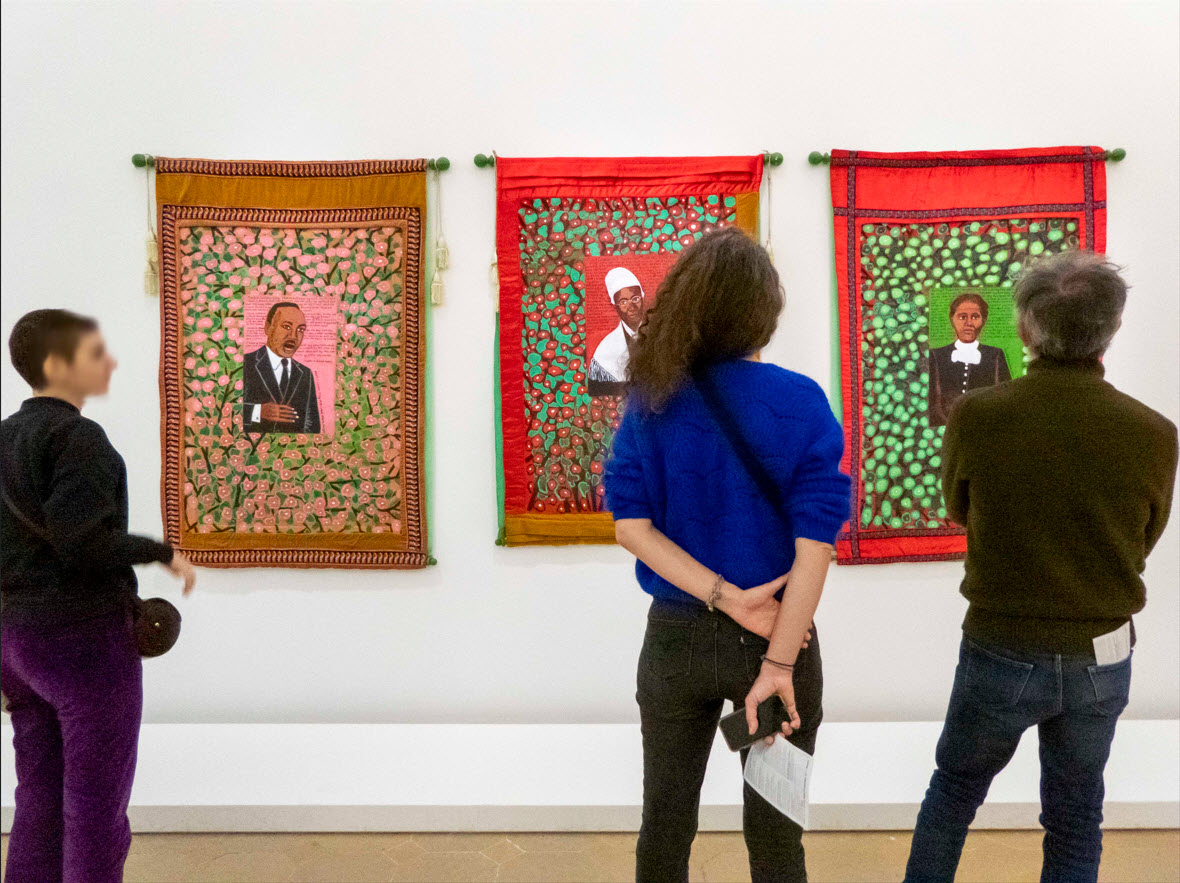 Observing Coming to Jones Road tankas
Observing Coming to Jones Road tankas
© Entrée to Black Paris
On the right wall, you will see Echoes of Harlem, the first quilt that Ringgold created in collaboration with her mother.
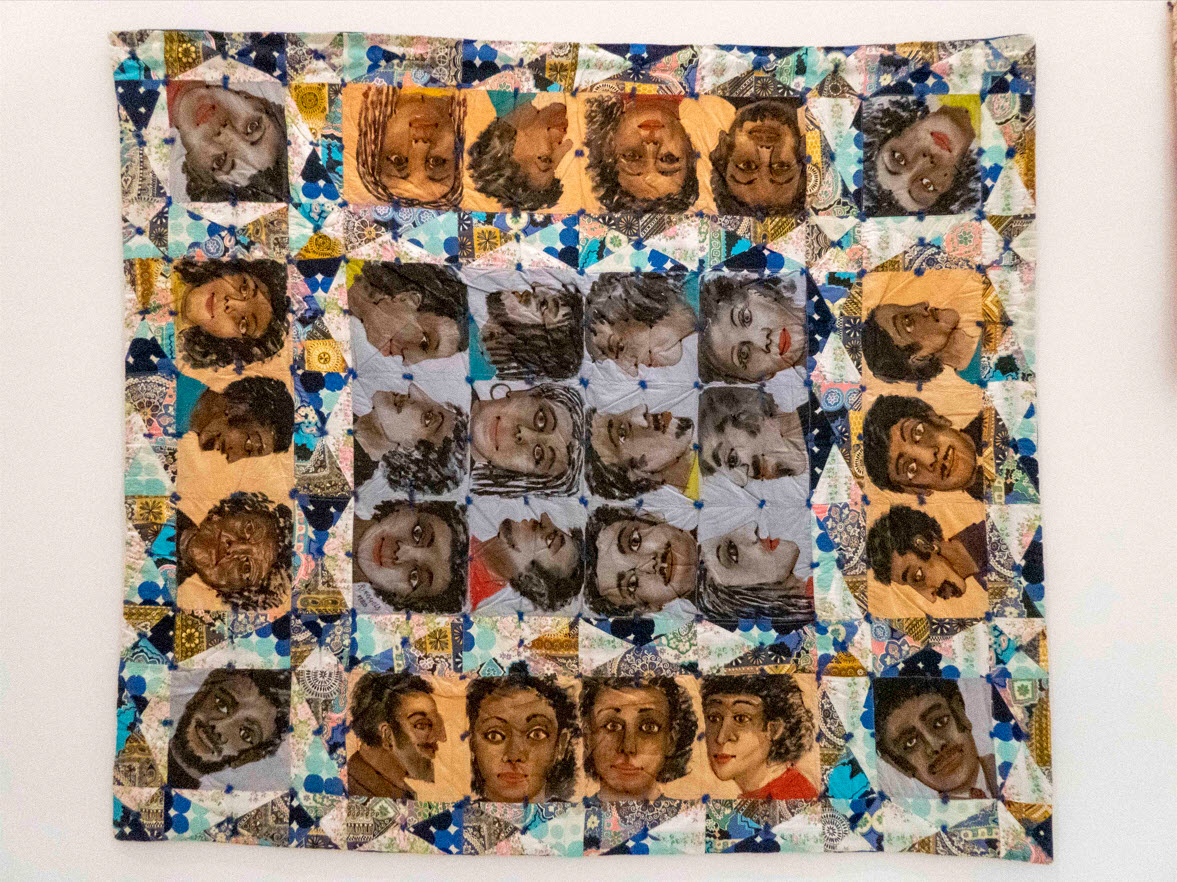 Echoes of Harlem
Echoes of Harlem
© Faith Ringgold
1980 Hand-painted cotton
Image © Entrée to Black Paris
At the rear, three haunting tankas from a 19-work series speak to the horrors of slave rape.
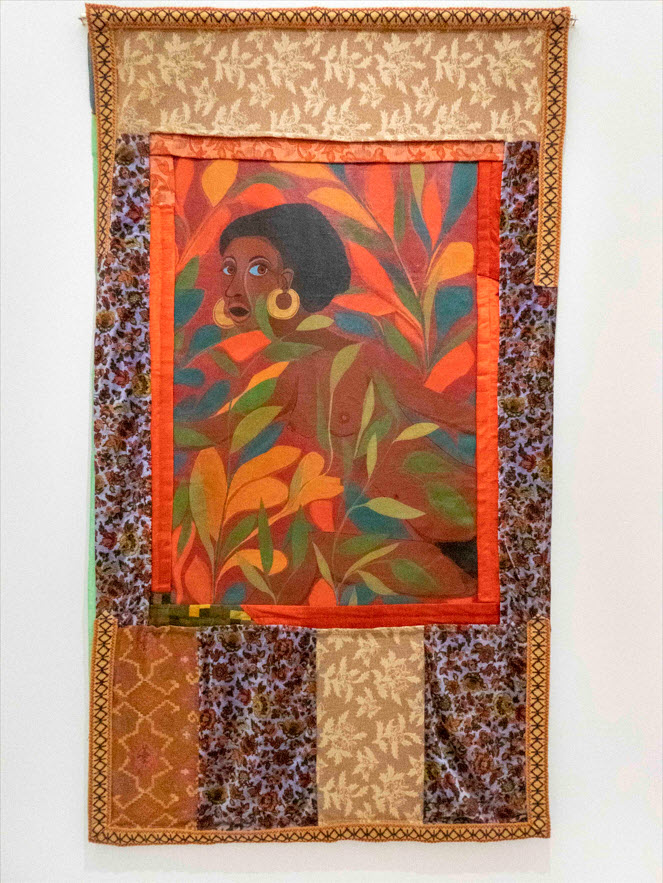 Slave Rape #2: Run You Might Get Away
Slave Rape #2: Run You Might Get Away
© Faith Ringgold
1974 Oil on canvas with fabric borders
Image © Entrée to Black Paris
Displayed in the following room are six story quilts - two from The Bitter Nest series and four from The French Collection series.
The Bitter Nest is a five-part fictional tale that Ringgold wrote to communicate her experiences with her two daughters. This story quilt series is less well known than the twelve-part The French Collection, which tells the fictional story of a young African-American woman who recounts her life in Paris in letters that she writes to her Aunt Melissa at home.
For both series, Ringgold presents the story on long rectangular patches of fabric that are sewn into the body of each quilt. The patches serve as a border of sorts, and you are forced to physically move from left to right and tiptoe and squat to read the enchanting story, while continually shifting your gaze to the center of the work to understand how the image relates to what you are reading.
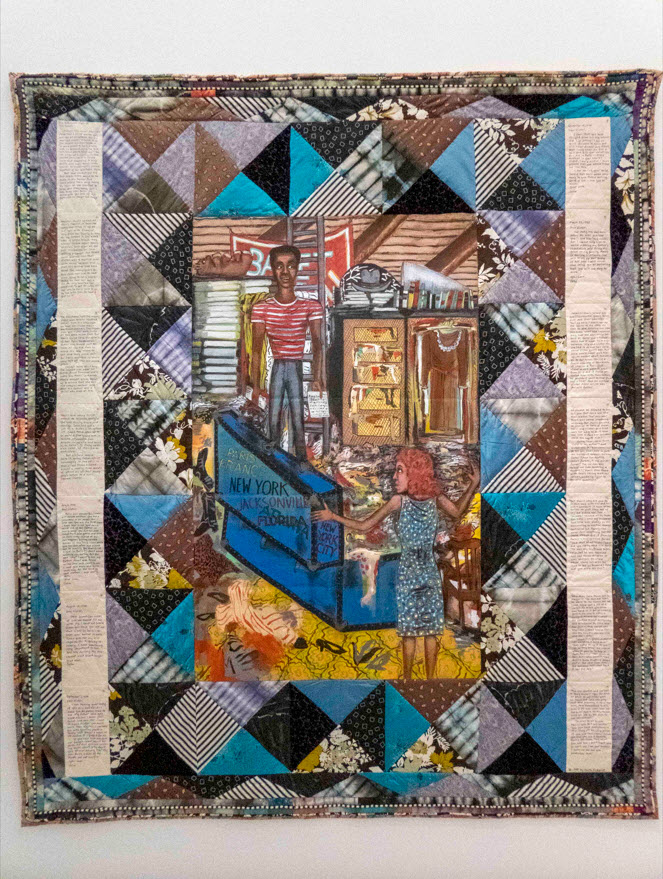 The Bitter Nest Part 4, The Letter
The Bitter Nest Part 4, The Letter
© Faith Ringgold
1988 Acrylic on canvas with printed, dyed, and pieced fabroc
Image © Entrée to Black Paris
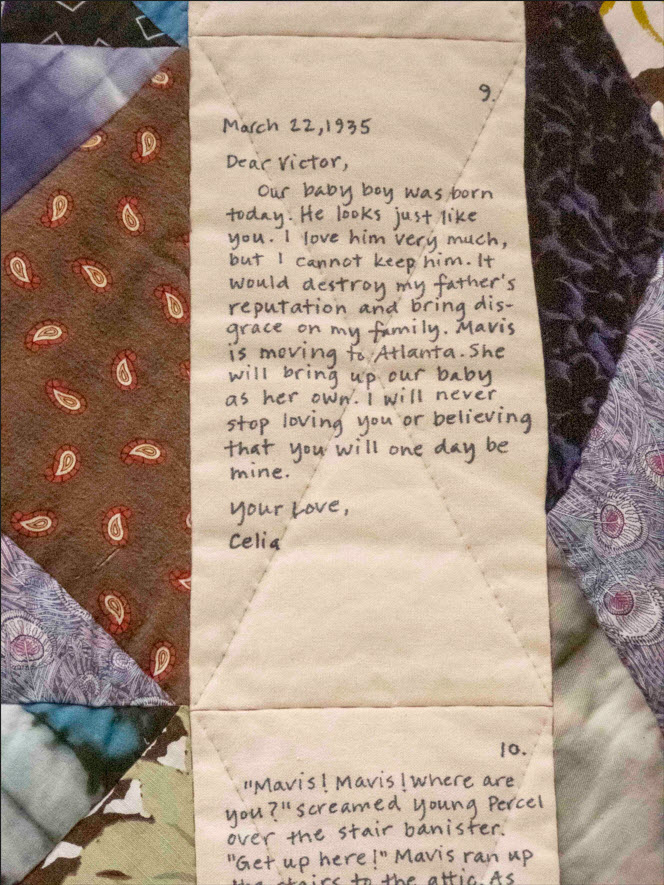 The Bitter Nest Part 4, The Letter
The Bitter Nest Part 4, The Letter
(Story Panel 9 and part of Story Panel 10)
© Faith Ringgold
1988 Acrylic on canvas with printed, dyed, and pieced fabroc
Image © Entrée to Black Paris
My favorite work in this room is The Sunflowers Quilting Bee at Arles because Ringgold represents eight of the U.S.' most influential historical Black women in it. She presents their names in the black, white, and purple border of the quilt they have made. A lonely Vincent Van Gogh watches the scene from a distance.
The story patches for The Sunflowers Quilting Bee at Arles are sewn into the quilt above and below the image.
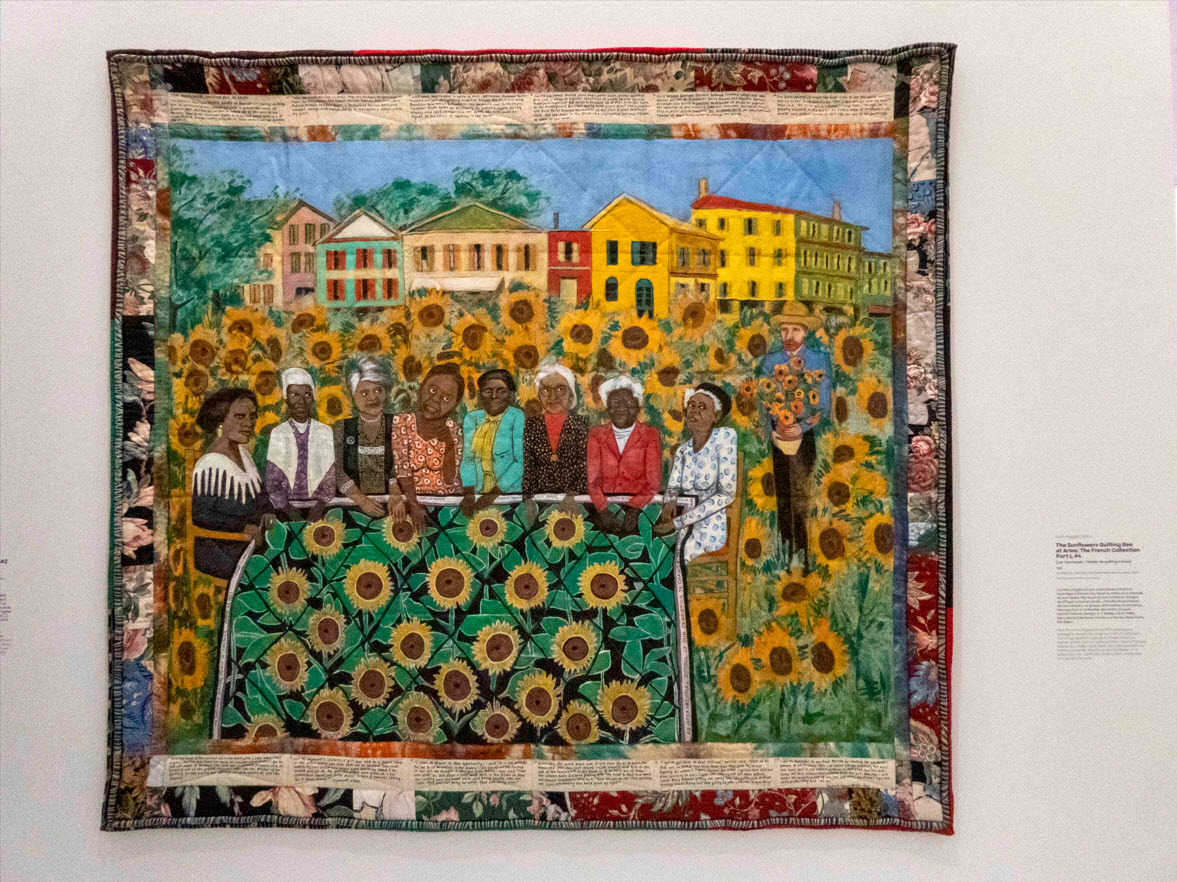 The Sunflowers Quilting Bee at Arles: The French Collection Part I, #4
The Sunflowers Quilting Bee at Arles: The French Collection Part I, #4
© Faith Ringgold
1991 Acrylic on canvas with fabric borders
Image © Entrée to Black Paris
The last room contains an installation called The Wake and Resurrection of the Bicentennial Negro (1975-1989). It represents a traveling, allegorical performance of the same name that Ringgold organized in response to the commemoration of the U.S. bicentennial:
We’re not going to celebrate that bicentennial because we weren’t free.
I’ll tell you what, we won’t celebrate, but let’s have a wake and resurrection.
~ Faith Ringgold
In this show, an African-American couple—Buba, who died of a drug overdose, and Bena, who died of grief—are resurrected in a better, more egalitarian world. The performance consisted of dances and declamations by masked students, gospel music, and recited excerpts from Dr. King's “I Have a Dream” speech.
The installation consists of five works from the Windows of the Wedding tanka series (the last such series created by Ringgold), four standing and two prone mixed-media figures, and flower pots.
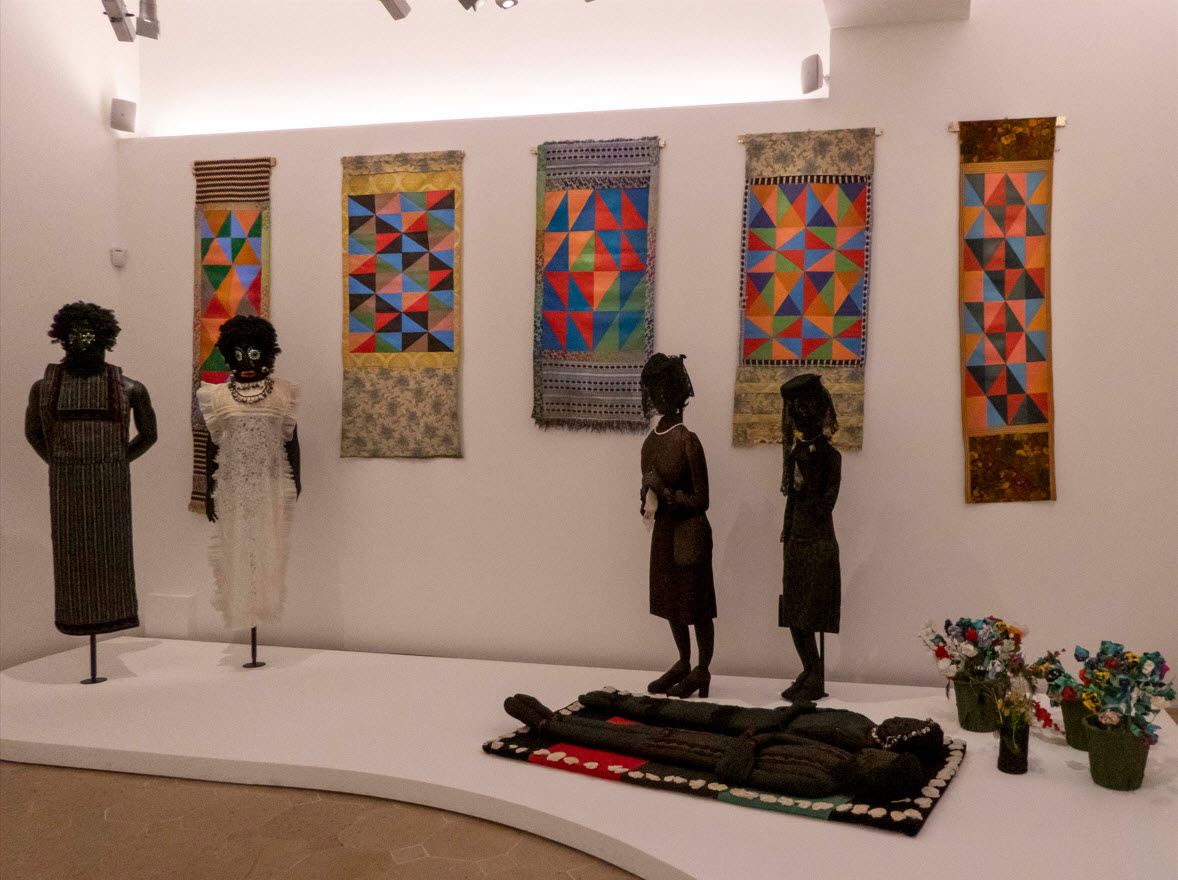 The Wake and Resurrection of the Bicentennial Negro
The Wake and Resurrection of the Bicentennial Negro
© Faith Ringgold
Image © Entrée to Black Paris
A powerful selection of audio tracks accompanies this installation. You will hear Aretha Franklin singing "Amazing Grace" and "Mary, Don't You Weep," Ella Fitzgerald singing "My Man," and Lil Green singing "Why Don't You Do Right?". You will also hear an instrumental recording of "Pressure Cooker" by Thelma Houston and Pressure Cooker.
After each song, you hear Dr. King speaking words from "I Have a Dream."
The Aretha Franklin recordings come from a live performance at New Temple Missionary Baptist Church in Los Angeles. I don't know that Ringgold could have chosen anything more fitting to set the tone for this installation.
To leave the exhibition, you must re-enter the French Collection room and exit it via the opening between Picasso's Studio and Le Café des Artistes.
Outside, you will find one final Faith Ringgold work - Tar Beach #2.
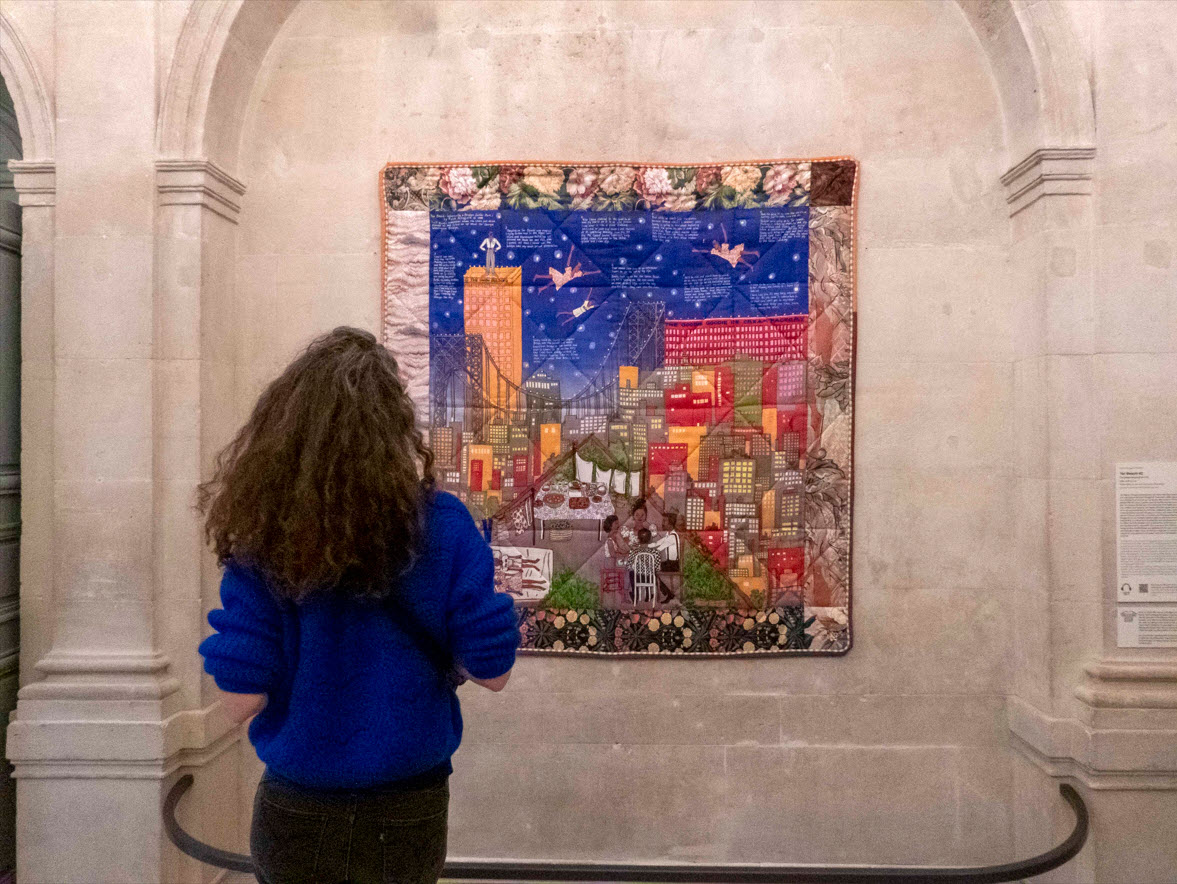 Observing Tar Beach #2
Observing Tar Beach #2
© Entrée to Black Paris
Created in 1990, it is one of 24 multicolored screen prints made from silk, cotton, and moiré synthetic fabric. It tells the story of Cassie, an eight-year-old girl who finds freedom in an imaginary flight above New York City.
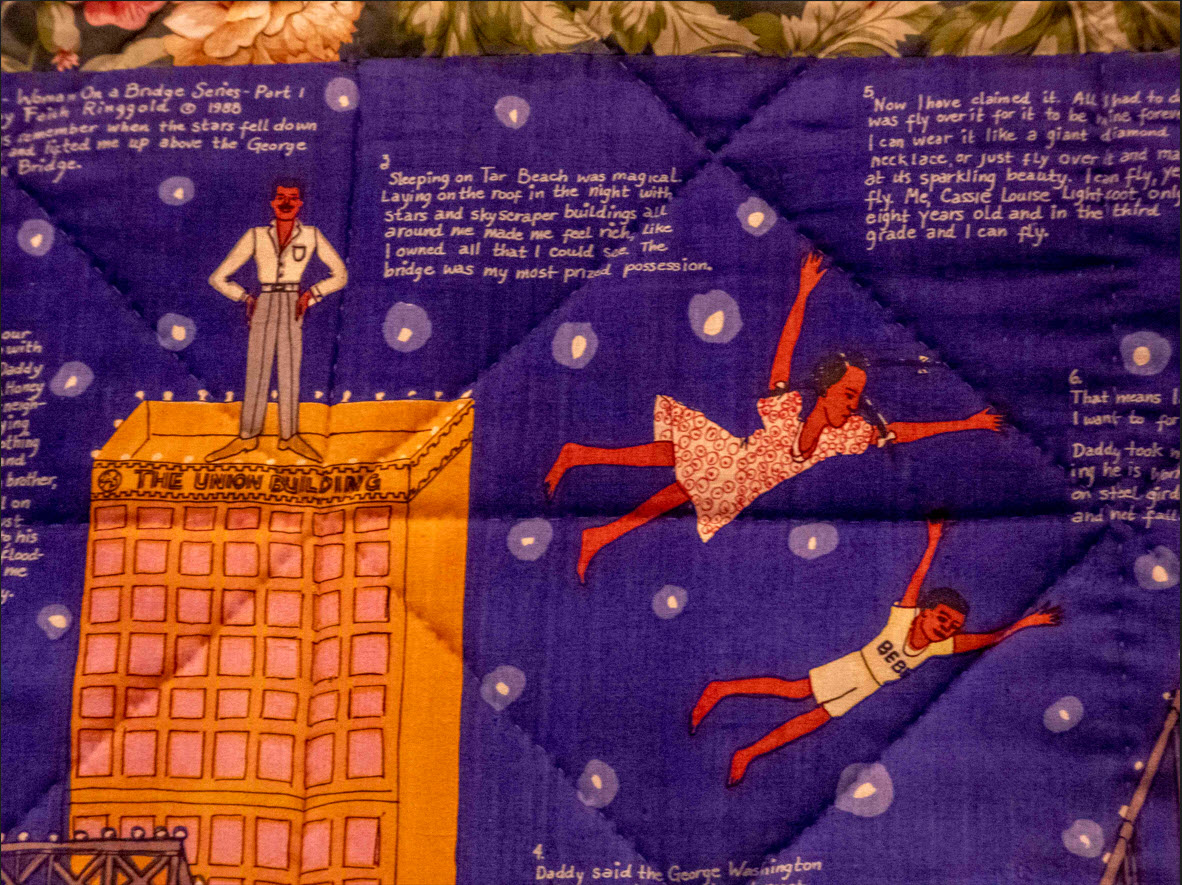 Tar Beach #2 (details)
Tar Beach #2 (details)
© Faith Ringgold
1990 Serigraph on silk with quilted fabric border
Images © Entrée to Black Paris
You will find a brief biography of Ringgold's life and samples of the exhibition catalog in a space behind Tar Beach #2. To purchase the catalog, you'll need to cross the vestibule of the museum to find the gift shop.
I was greatly impressed by the range of books relevant to the exhibition that the museum has stocked in addition to the catalog and Faith Ringgold swag they are offering for sale. There are several books about Angela Davis, the Black Panthers, and Rosa Parks. Children's books include a publication about Maya Angelou and two books written by Toni Morrison and her son, Slade.
All are in French.
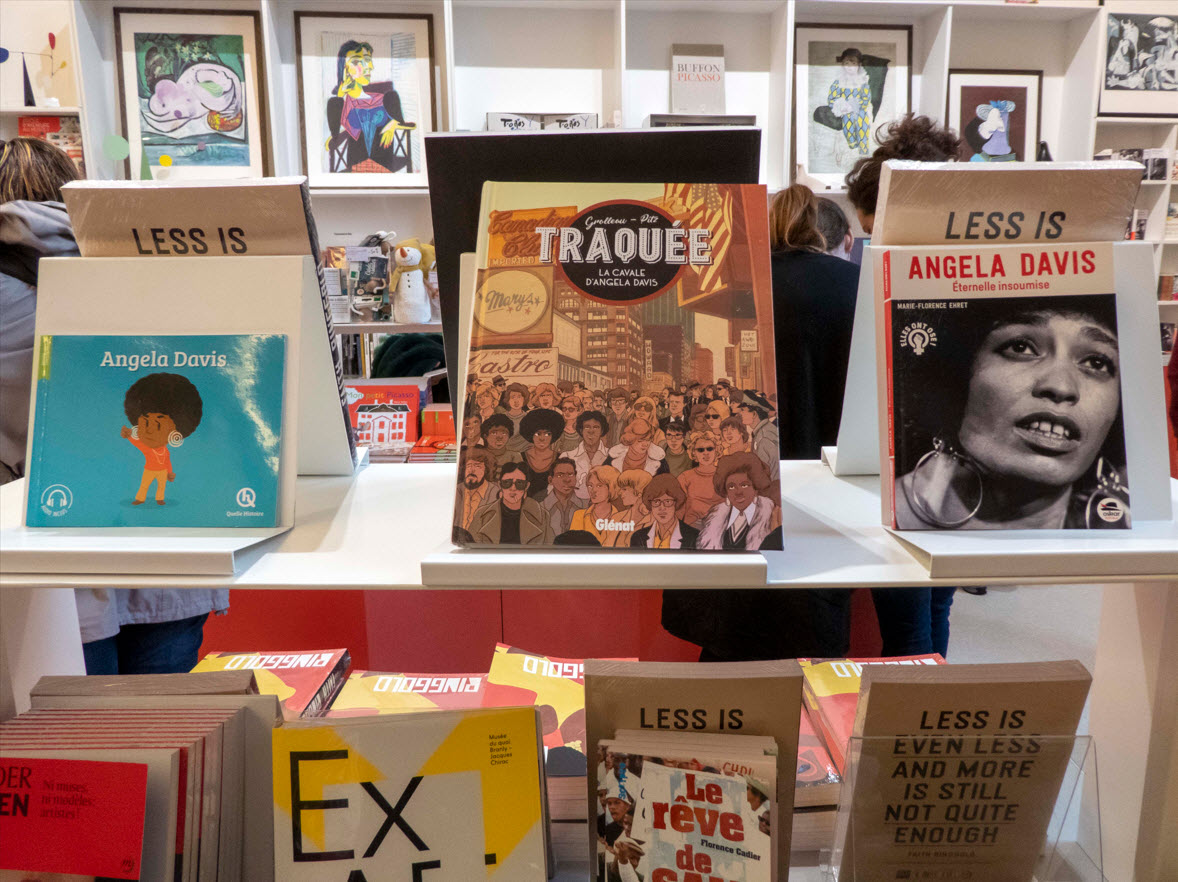
Books about Angela Davis
© Entrée to Black Paris
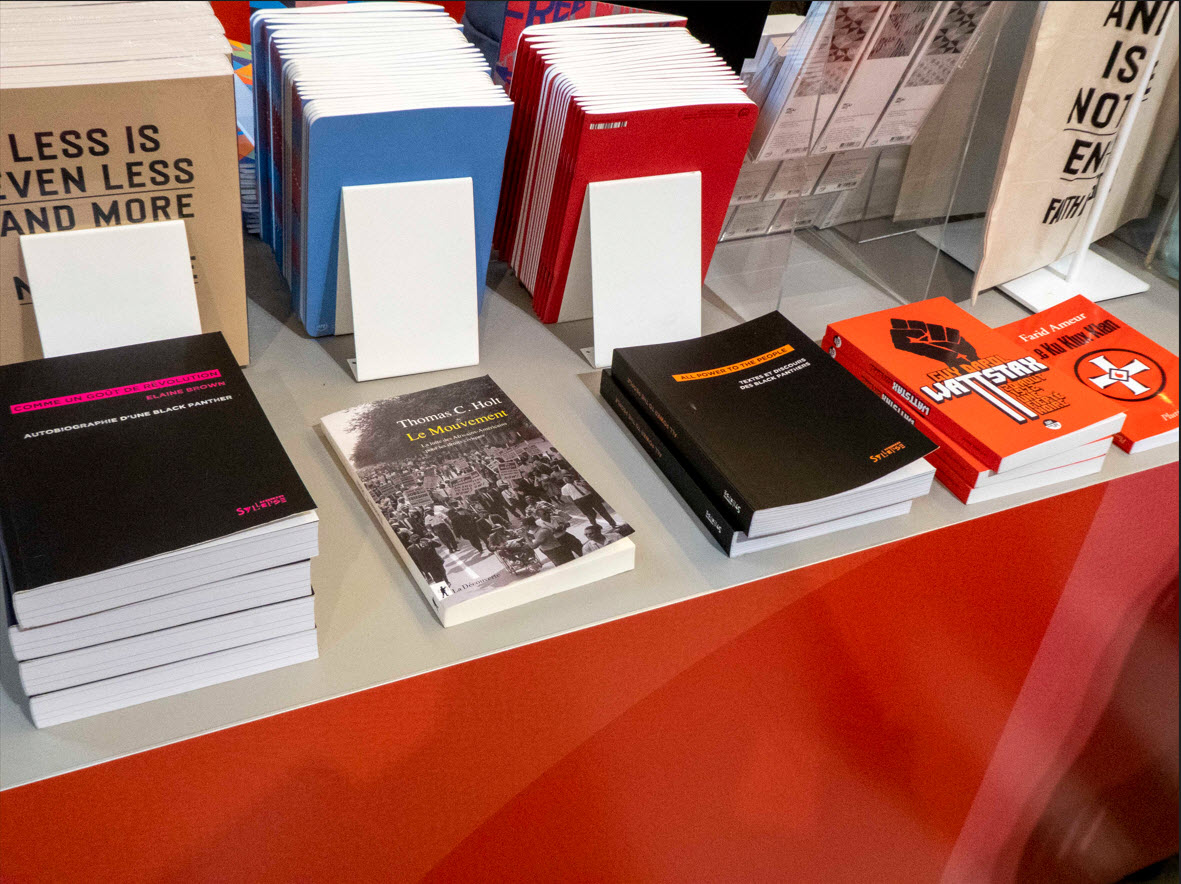
Books about the Black Panthers
© Entrée to Black Paris
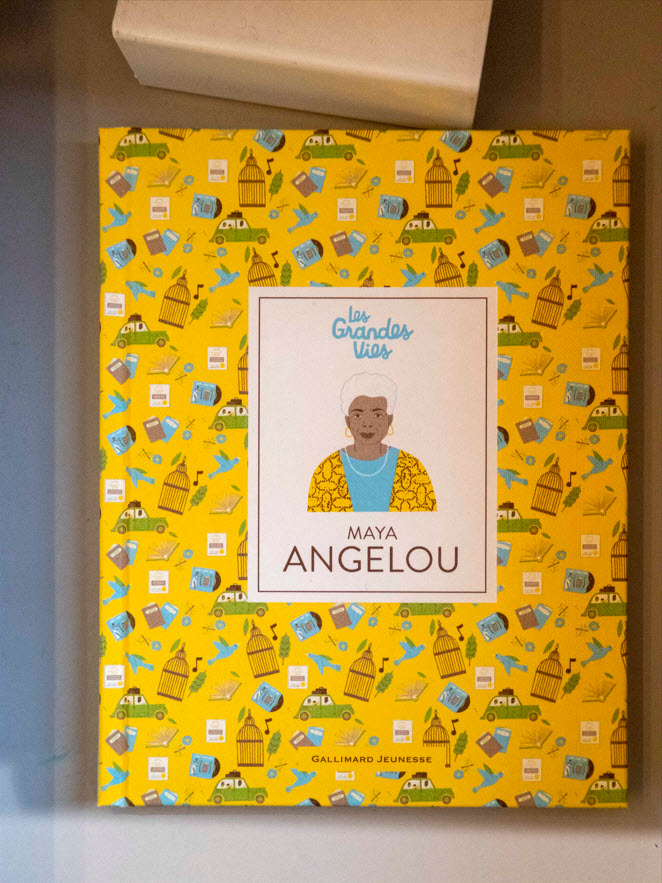
Book about Maya Angelou
© Entrée to Black Paris
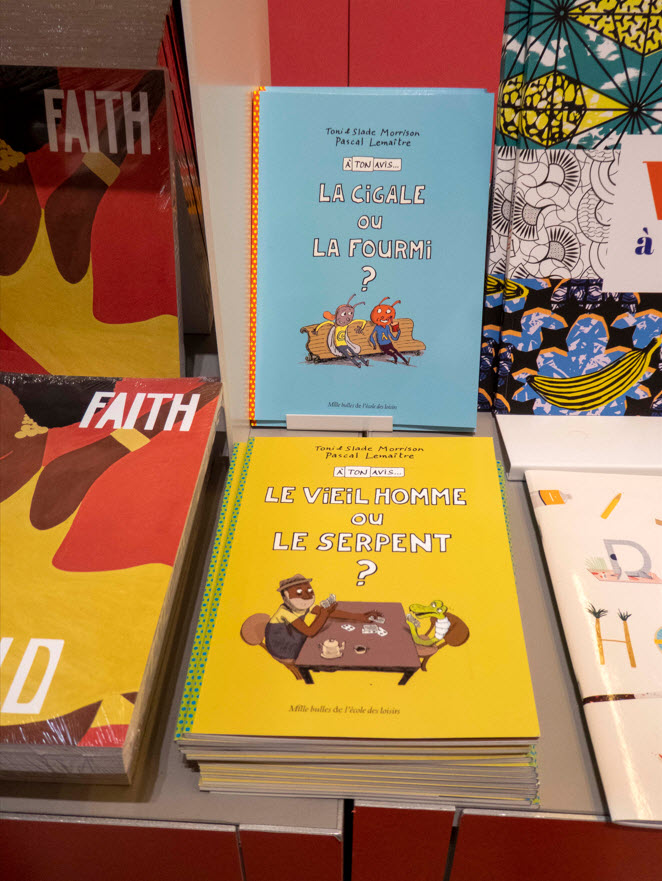 Books by Toni & Slade Morrison
Books by Toni & Slade Morrison
© Entrée to Black Paris
Black Is Beautiful is a must-see exhibition. It will be on display through July 2, 2023. If you're in Paris or if you're planning to visit between now and then, put this on your calendar!

 Our Walk: Black History in and around the Luxembourg Garden - Click here to book!
Our Walk: Black History in and around the Luxembourg Garden - Click here to book!